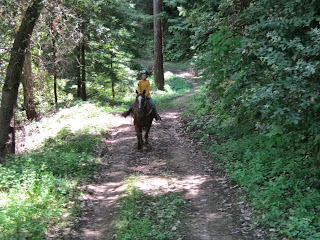by Laura Crum
So
today I have another gift for you. In honor of Halloween, my second novel,
Hoofprints, is free today and tomorrow (Oct 30th and 31st)
as a Kindle edition. Hoofprints features my series protagonist, veterinarian
Gail McCarthy, and centers around the world of reined cowhorses. Hoofprints is
rated four and a half stars on Amazon.
Click on the title to find the free edition and to read more about the
book, as well as plenty of reviews.
It
occurred to me that perhaps some potential readers might wonder what
credentials I have to write about about reined cowhorses and/or cutting horses.
So today I thought I’d fill you in on my background in this area.
When I was in my twenties, I was
obsessed with cowhorses. I went to work for several well known cowhorse and
cutting horse trainers as an assistant, and I rode many, many accomplished
horses in these barns, as well as helped train over a hundred young horses. I
trained my good gelding, Gunner, to be first a reined cowhorse (we competed at
the Snaffle Bit Futurity and placed in the Non-Pro and the Ladies Divisions),
and then a cutting horse (we placed in the Non-Pro Division of the Northwest
Superstakes when Gunner was four years old and went on to win numerous smaller
awards, including the cutting at our local county fair). The photo below shows
Gunner and me winning the cutting at the Santa Cruz County Fair when Gunner was
eight years old.
Along
the way, I rubbed shoulders with some of the “greats” of both the cowhorse and
the cutting horse world. We’re talking world champion trainers, incredibly
wealthy clients, and some of the most talented horses you could ever imagine. I
saw things that came right out of a mystery novel, from outright scams and
incredible abuse, to charming sociopaths who would rip you off without a second
thought. I also met some genuinely good-hearted folks who knew more about
training a horse than most backyard horsemen can even imagine. I learned a lot.
I saw a lot of, uhmm, colorful things. And when I began writing mystery novels
at the age of thirty, I knew where I would set those novels.
And
so Cutter, my first novel, was set in the world of cutting horses. For those of
you who have read the book, I can assure you that every single character and
incident was based (sometimes loosely) on something I actually saw or knew
about (with the exception of the murders, of course). The horses, too, are all
horses I have known. Cutter is rated 4 stars on Amazon and the Kindle edition
is currently just 99 cents. Click on the title to find the book, and to read
more info and reviews.
Having
finished Cutter, I knew I wanted to do justice to the even more cutthroat world
of reined cowhorses, with its own subset of wealthy owners and high stakes
trainers. And so Hoofprints was born. Here is a brief synopsis of the book (from Amazon):
In this second installment in the Gail McCarthy series, the young vet stumbles upon two murdered bodies in the course of a routine call. When a midnight emergency turns into an attempt on her life, Gail knows she must uncover the motive before its too late. Plenty of authentic horse lore and an action packed plot from an author who spent most of her life training cowhorses and knows whereof she speaks.
Hoofprints
has always been one of the most popular titles in my mystery series. It stands
well on its own, but also holds its place as the second in a twelve book series
about the life of veterinarian Gail McCarthy. One of the main characters in the
book is Plumber, who, in real life is a horse I bought as an unbroken
three-year-old and trained myself. Plumber went on to become a winning rope
horse, bringing home numerous trophy saddles and buckles and many, many
paychecks. The real Plumber is very much as described in the book—a sweet,
kind, willing horse who really likes people. I still own Plumber—he is 24 years
old and lives here with me as a retired horse and we all give him lots of love
and attention.
Plumber
as a baby, next to his mother, Bucky.
Plumber
packing my son and me—yes, I know we should have worn helmets, but Plumber
packed us like this without one misstep for three years.
Plumber
today--24 years old.
So
for anyone who enjoys a good mystery and loves horses—here is a Halloween gift
for you. Hoofprints will be free today and tomorrow as a Kindle edition. Get it
while you can.
Happy
Halloween!

























